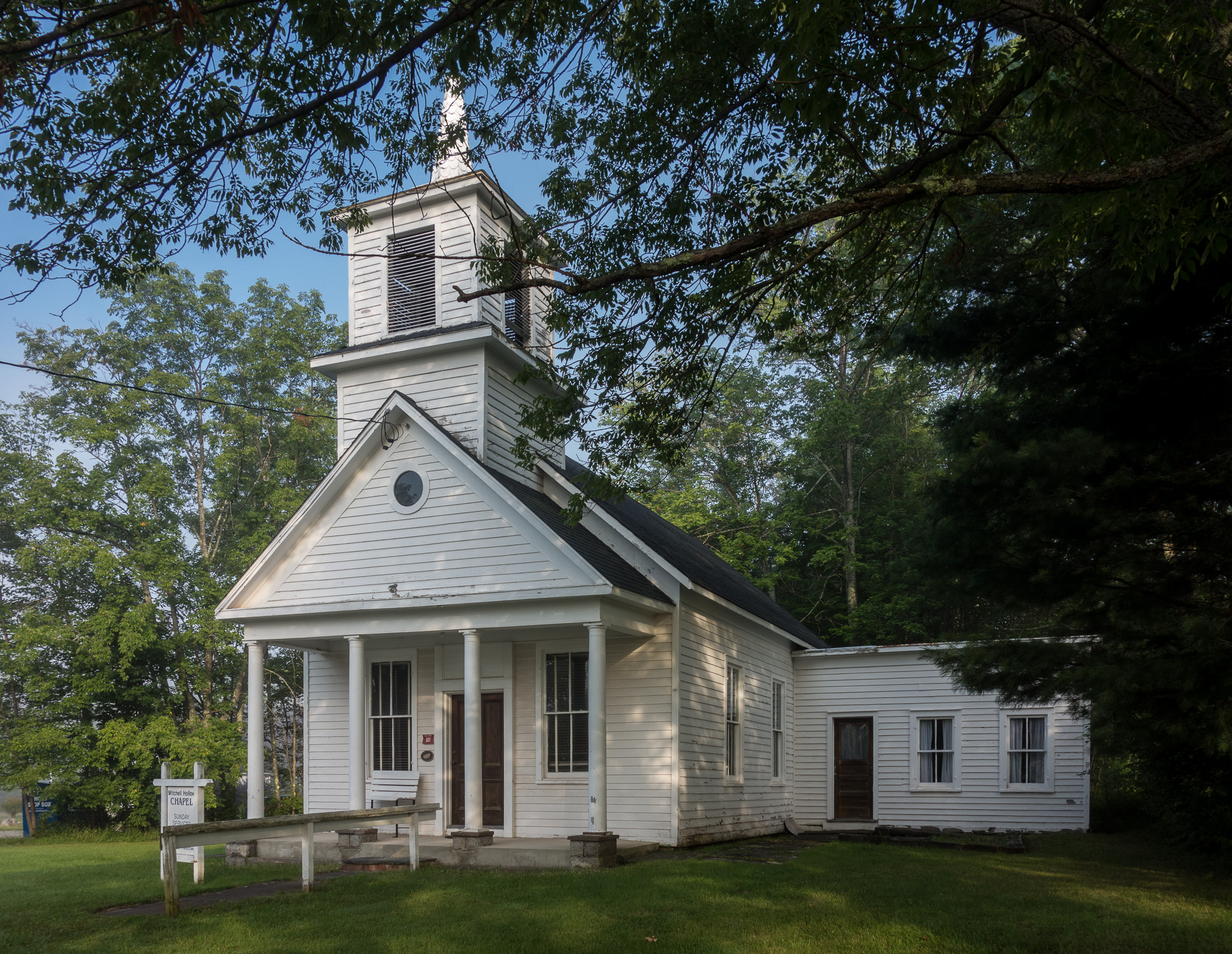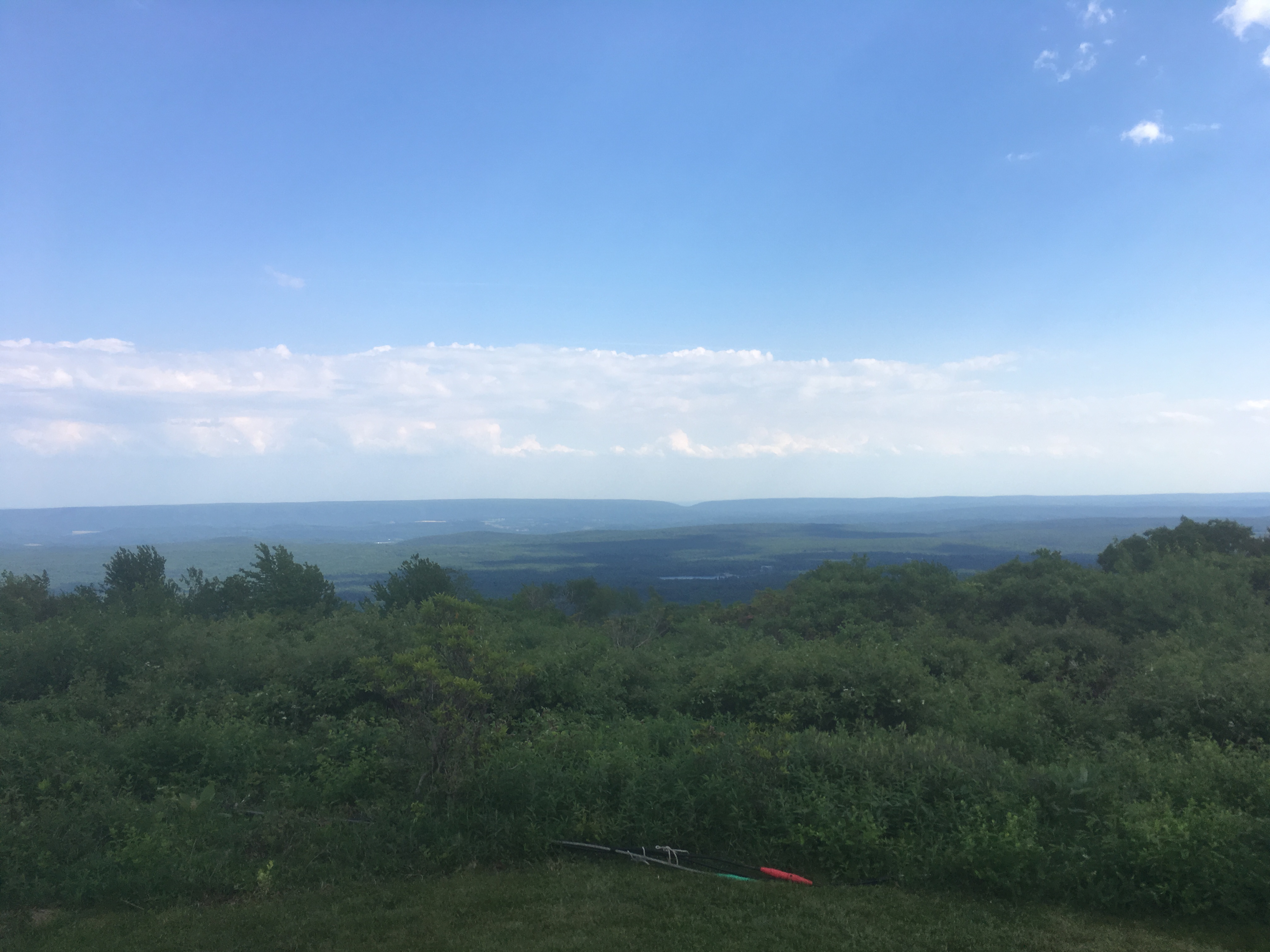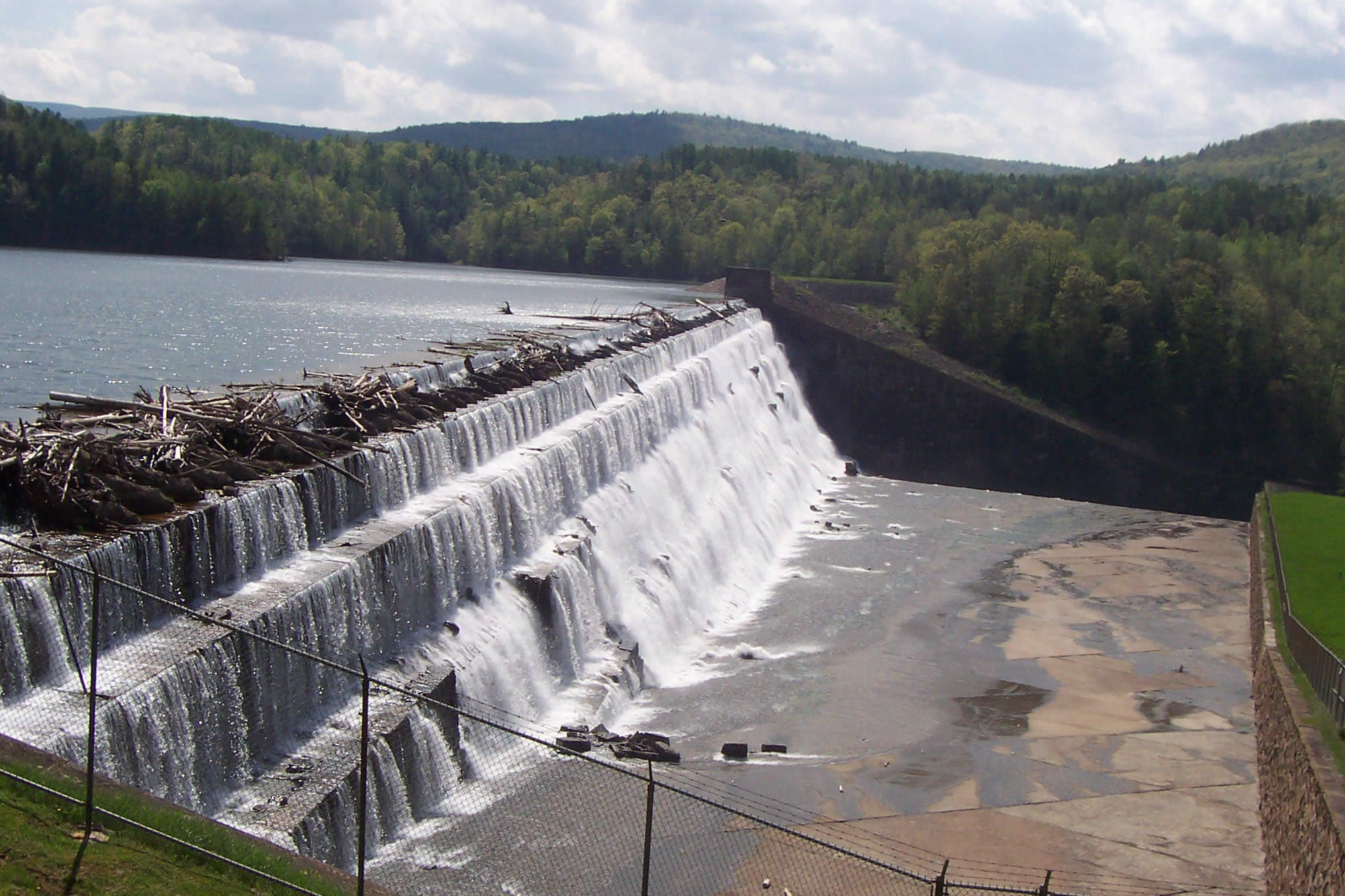|
Catskills
The Catskill Mountains, also known as the Catskills, are a physiographic province of the larger Appalachian Mountains, located in southeastern New York. As a cultural and geographic region, the Catskills are generally defined as those areas close to or within the borders of the Catskill Park, a forest preserve protected from many forms of development under New York state law. Geologically, the Catskills are a mature dissected plateau, a flat region subsequently uplifted and eroded into sharp relief by watercourses. The Catskills form the northeastern end of the Allegheny Plateau (also known as the Appalachian Plateau). The Catskills were named by early Dutch settlers. They are well known in American society as the setting for films and works of art, including many 19th-century Hudson River School paintings, as well as for being a favored destination for vacationers from New York City in the mid-20th century. The region's many large resorts gave many young stand-up comedians ... [...More Info...] [...Related Items...] OR: [Wikipedia] [Google] [Baidu] |
Esopus Creek
Esopus Creek is a tributary of the Hudson River that drains the east-central Catskill Mountains in the U.S. state of New York. From its source at Winnisook Lake on the slopes of Slide Mountain, the Catskills' highest peak, it flows across Ulster County to the Hudson at Saugerties. Many tributaries extend its watershed into neighboring Greene County and a small portion of Delaware County. Midway along its length, it is impounded at Olive Bridge to create Ashokan Reservoir, the first of several built in the Catskills as part of New York City's water supply system. Its own flow is supplemented above the reservoir by the Shandaken Tunnel, which carries water from the city's Schoharie Reservoir into the creek. The creek, originally known by the Native Americans in the area as ''Atkarkaton'' or ''Atkankarten'' and by Dutch settlers as the "Esopus Kill", takes its name from the Esopus tribe of the Lenape, who were living around the lower Esopus when the Dutch first explored ... [...More Info...] [...Related Items...] OR: [Wikipedia] [Google] [Baidu] |
Slide Mountain (Ulster County, New York)
Slide Mountain is the highest mountain, peak in the Catskill Mountains of the U.S. state of New York (state), New York. It is located in the Town (New York), town of Shandaken, New York, Shandaken in Ulster County, New York, Ulster County. While the contour line on topographic maps is generally accepted as its height, the exact elevation of the summit has never been officially determined by the U.S. Coast and Geodetic Survey, and many informal surveys suggest the mountain may actually top 4,200 feet (1,280 m) above sea level. While it was not identified as the range's highest peak until the late 19th century, it has played a prominent role in History of the Catskill Mountains, Catskill history. Renowned naturalist John Burroughs wrote memorably of his climbs up Slide, and it helped get the Catskills added to New York's Forest Preserve (New York), Forest Preserve. Bicknell's thrush was first identified on its summit. Geography Like most other Catskill peaks, Slide's summit is ge ... [...More Info...] [...Related Items...] OR: [Wikipedia] [Google] [Baidu] |
Phoenicia, New York
Phoenicia is a hamlet (and census-designated place) of Shandaken in Ulster County, New York, United States. The population was 309 at the 2010 census, making it the highest populated community in the town. The village center is located just off Route 28 at its junction with Route 214 and is nestled at the base of three peaks, Mount Tremper, Romer Mountain, and Sheridan Mountain. The community sits at the confluence of the Esopus Creek and Stony Clove Creek. A popular getaway for New Yorkers, the hamlet has frequented many tourism guides as among the best vacation towns in the greater New York City area. History The geographic area that would eventually be named Phoenicia was fertile hunting and fishing land for the Mohawk, Mohican, and Lenape peoples for hundreds of years before European settlers arrived. Of particular note are the Esopus Lenape, who are believed to be the people who spent the most time in the area. The first European settlement in the area is believed to b ... [...More Info...] [...Related Items...] OR: [Wikipedia] [Google] [Baidu] |
Windham, New York
Windham is a town in Greene County, New York, United States. The population was 1,703 at the 2010 census. The town was probably named for the town or county of Windham, Connecticut, as many of its earliest settlers came from that state as well as other parts of New England. The town has two nicknames: "Land in the Sky" and "Gem of the Catskills". Windham is in the west-central part of the county on the northern boundary of the Catskill Park. History The region was first settled around 1780. The town was formed from the town of Woodstock in 1798 while still part of Ulster County. After the formation of Greene County, several other towns were formed from parts of Windham. These towns include Hunter and Lexington (1813), Prattsville (1833), and part of Ashland in 1848. In 1900, the town's population was 1,240. In 1937, Camp Highland, a Nazi summer camp for German-American boys, ran at a site near Windham, NY. The major source of income in Windham is the Windham Mountain ski ... [...More Info...] [...Related Items...] OR: [Wikipedia] [Google] [Baidu] |
Hunter (village), New York
Hunter is a village in Greene County, New York, United States. The population was 429 at the 2020 census, down from 502 at the 2010 census. The village is in the northwestern part of the town of Hunter on Route 23A. History The community was initially called "Edwardsville" after William Edwards, who founded the village by building a tannery there. The village was incorporated in 1896. Geography Hunter is located in western Greene County at (42.208549, -74.21398), within the Catskill Mountains, in the valley of Schoharie Creek. New York State Route 23A is the village's Main Street, leading east to Tannersville and to Catskill. To the west NY 23A leads down Schoharie Creek to Prattsville. According to the United States Census Bureau, the village has a total area of , of which is land and , or 1.81%, is water. Demographics As of the census of 2000, there were 490 people, 238 households, and 123 families residing in the village. The population density was 303.0 peopl ... [...More Info...] [...Related Items...] OR: [Wikipedia] [Google] [Baidu] |
Pocono Mountains
The Pocono Mountains, commonly referred to as the Poconos , are a geographical, geological, and cultural region in Northeastern Pennsylvania. They overlook the Delaware River and Delaware Water Gap to the east, Lake Wallenpaupack to the north, Wyoming Valley and the Coal Region to the west, and the Lehigh Valley to the south. The name Pocono is derived from the Munsee word Pokawachne, which means "Creek Between Two Hills". Much of the Poconos region lies within the Greater New York–Newark, NY–NJ–CT–PA Combined Statistical Area. The wooded hills and valleys have long been a popular recreation area, accessible within a two-hour drive to millions of metropolitan area residents, with many Pocono communities having resort hotels with fishing, hunting, skiing, and other sports facilities. The Poconos are an upland of the larger Allegheny Plateau, forming a escarpment. Population The Pocono Mountains are a popular recreational destination for local and regional visitors. W ... [...More Info...] [...Related Items...] OR: [Wikipedia] [Google] [Baidu] |
Tannersville, New York
Tannersville is a village in Greene County, New York, United States. The village is in the north-central part of the town of Hunter on Route 23A. The population was 539 at the 2010 census, up from 448 in 2000. History The village was founded around lumber mills and tanneries. It was incorporated in 1895. Tannersville's tanning business collapsed in the mid-19th century. It was gradually replaced by the summer resort trade, which reached its peak in 1882 when the railroad came to Tannersville. However, the rise of the automobile in the early 20th century led to a steady economic decline, as travelers were no longer rooted to one spot for an entire summer. Due to its close proximity to Hunter Mountain ski area, it serves as the local commercial district, with inns, restaurants, and shopping. Tannersville has experienced a revival in the 21st century. The Hunter Foundation has implemented the town-wide "Paint Program" — the vision of Elena Patterson, a local artist — with th ... [...More Info...] [...Related Items...] OR: [Wikipedia] [Google] [Baidu] |
Twin Mountain (New York)
Twin Mountain is a mountain located in Greene County, New York. Twin gets its name from its two summits; the lower, 3,590-ft (1,090 m) peak is about to the southeast of the higher. The mountain is part of the Devil's Path range of the Catskill Mountains. To the northwest, Twin Mtn. is separated from Sugarloaf Mountain by Pecoy Notch; to the southeast, Twin Mtn. is separated from Indian Head Mountain by Jimmy Dolan Notch. Twin Mountain stands within the watershed of the Hudson River, which drains into New York Bay. The northwest end and northeast side of Twin Mtn. drain into the headwaters of Schoharie Creek, thence into the Mohawk River, and the Hudson River. The southeast end of Twin Mtn. drains into Saw Kill, thence into Esopus Creek, and the Hudson River. The southwest side of Twin drains into Beaver Kill, thence into Esopus Creek. Twin Mountain is contained within New York's Catskill State Park. The Devil's Path hiking trail traverses the summit ridge of Twin. ... [...More Info...] [...Related Items...] OR: [Wikipedia] [Google] [Baidu] |
Palenville, New York
Palenville is a hamlet and census-designated place (CDP) in Greene County, New York, United States. The population was 1,037 at the 2010 census. Palenville is in the southwestern part of the town of Catskill, located at the junction of Routes 23A and 32A. It lies at the foot of Kaaterskill Clove, at the base of the Catskill Mountains. Kaaterskill Creek, exiting the Clove, runs through the town, and was spanned by a swinging footbridge, destroyed during Tropical Storm Irene. The creek provides a number of swimming holes in the summer months, and the Long Path runs through the town. History Palenville takes its name from the Palen family, who built and operated tanneries throughout the Catskills starting the 1820s. The tannery era was short. When the local supply of hemlock bark was exhausted, the tannery closed, leaving Palenville to reinvent itself. With many waterfalls and natural vistas nearby, Palenville was an important center of the Hudson River School of painting duri ... [...More Info...] [...Related Items...] OR: [Wikipedia] [Google] [Baidu] |
Ulster County, New York
Ulster County is a county in the U.S. state of New York. It is situated along the Hudson River. As of the 2020 census, the population was 181,851. The county seat is Kingston. The county is named after the Irish province of Ulster. History Founding and formation When part of the New Netherland colony, Dutch traders first called the area of present-day Ulster County "Esopus", a name borrowed for convenience from a locality on the opposite side of the Hudson. The local Lenape indigenous people called themselves Waranawanka, but soon came to be known to the Dutch as the "Esopus Indians" because they were encountered around the settlement known as Esopus. In 1652, Thomas Chambers, a freeholder from the Manor of Rensselaerswyck, purchased land at Esopus. He and several others actually settled and began farming by June, 1653. The settlements grew into the village of Wiltwijck, which the English later named Kingston. In 1683, the Duke of York created 12 counties in his province, ... [...More Info...] [...Related Items...] OR: [Wikipedia] [Google] [Baidu] |
Sullivan County, New York
Sullivan County is a county in the U.S. state of New York. As of the 2020 census, the population was 78,624. The county seat is Monticello. The county's name honors Major General John Sullivan, who was labeled at the time as a hero in the American Revolutionary War in part due to his successful campaign against the Iroquois (see Sullivan Expedition). The county was the site of hundreds of Borscht Belt hotels and resorts, which had their heyday from the 1920s through the 1970s. In 2010, the state's center of population was at the southern edge of Sullivan County. History When the Province of New York established its first twelve counties in 1683, the present Sullivan County was part of Ulster County. In 1809, Sullivan County was split from Ulster County. In the late 19th century, the Industrial Revolution and the advent of factories driven by water power along the streams and rivers led to an increase in population attracted to the jobs. Hamlets enlarged into towns. As in ... [...More Info...] [...Related Items...] OR: [Wikipedia] [Google] [Baidu] |
Schoharie County, New York
Schoharie County ( ) is a county in the U.S. state of New York. As of the 2020 census, the population was 29,714, making it the state's fifth-least populous county. The county seat is Schoharie. "Schoharie" comes from a Mohawk word meaning "floating driftwood." Schoharie County is part of the Albany-Schenectady-Troy, NY Metropolitan Statistical Area. History The large territory of the county (much of upstate and western New York) was long occupied by the Mohawk Nation and, to the west, the other four tribes of the Haudenosaunee Confederacy (increased to six with the migration of the Tuscarora from the South to New York in 1722). After European colonization of the Northeast started, the Mohawk had a lucrative fur trade with the French coming down from Canada, as well as the early Dutch colonists, and later British and German colonists. Some Palatine Germans, who worked in camps on the Hudson to pay off their passage in 1710, later settled in this county in the 1720s and 30 ... [...More Info...] [...Related Items...] OR: [Wikipedia] [Google] [Baidu] |





.jpg)

